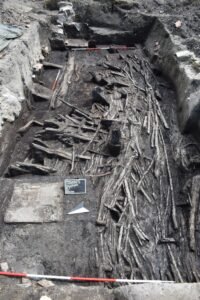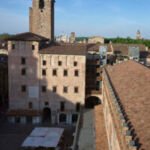 Archaeologists excavating a planned construction site in the historic center of Wiedenbrück unearthed a large amount of wood arranged in a purposeful fashion, likely intended to reclaim land adjacent to a waterway. The wet soil near a waterway had preserved the small logs and branches, and also preserved pottery, animal bones and leather shoe soles. The pottery dates it to the 13th century.
Archaeologists excavating a planned construction site in the historic center of Wiedenbrück unearthed a large amount of wood arranged in a purposeful fashion, likely intended to reclaim land adjacent to a waterway. The wet soil near a waterway had preserved the small logs and branches, and also preserved pottery, animal bones and leather shoe soles. The pottery dates it to the 13th century.
The wooden stakes were laid in two or three rows know as fascines, used to reinforce sloping terrain like a kind of retaining wall. Worked stakes and plain branches run east-west with willow rods woven in between them. South of the rows, thin birch twigs were laid flat on the ground to help secure the subsoil. Archaeologists believe its positioning indicates the network was used to prevent water penetration.
 A small town in northwestern Germany’s Westphalia region, Wiedenbrück grew around a church built there in the late 8th century. The earliest archaeological remains in Wiedenbrück are from a basilica built after 900 and within 50 years of that, Wiedenbrück was part of the territory of the Bishopric of Osnabrück, with market and mint rights granted to the bishop by the king of East Francia and future Holy Roman Emperor Otto I. The oldest surviving coins on the archaeological record, however, date to 1230, almost 300 years after the mint rights were granted, around the same time as the wood structure was built.
A small town in northwestern Germany’s Westphalia region, Wiedenbrück grew around a church built there in the late 8th century. The earliest archaeological remains in Wiedenbrück are from a basilica built after 900 and within 50 years of that, Wiedenbrück was part of the territory of the Bishopric of Osnabrück, with market and mint rights granted to the bishop by the king of East Francia and future Holy Roman Emperor Otto I. The oldest surviving coins on the archaeological record, however, date to 1230, almost 300 years after the mint rights were granted, around the same time as the wood structure was built.
For the history of the town of Wiedenbrück, the excavation findings open a window into the exciting period of growth around 800 years ago: “The elaborate wooden construction was probably built during the construction of the new town shortly before the middle of the 13th century in order to make use of a peaty depression east of an old arm of the Ems that had always been unsuitable for settlement,” explains Sven Spiong, head of the Bielefeld branch. “Such medieval land reclamation or densification measures in towns can be observed again and again, recently in Minden or Rietberg, for example. When the town grew, previously unused areas were prepared as building land.”
The continued use of the land along the waterway was demonstrated by the embankments that covered the entire structure in the 14th or 15th century, thereby raising the land and making it drier. Finally, the final settlement of the site is evidenced by posts up to two meters long that were driven through the older embankment and the wooden structure underneath. One of these posts turned out to be a reused, slightly charred half-timbered beam. Scientific research is now intended to clarify whether these posts could be part of the first written record of development on the site from around 1500.







